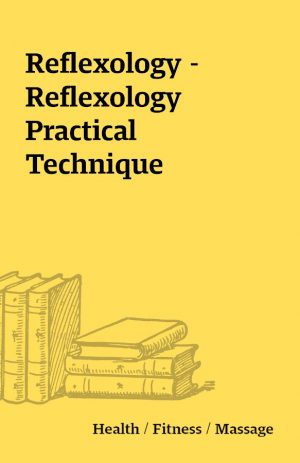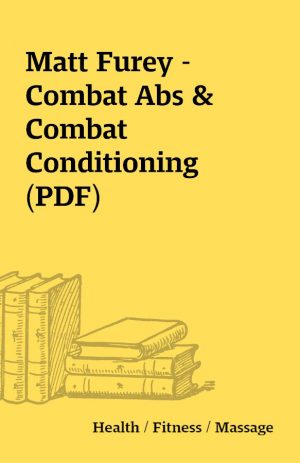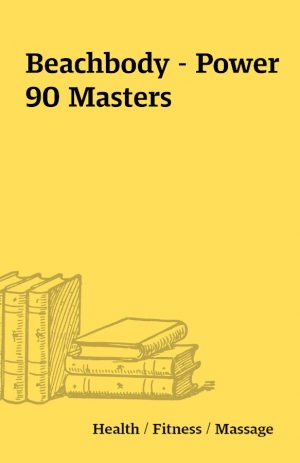Mel C. Siff – Facts and Fallacies of Fitness 6th Ed. 2003
Mel.Siff.Facts.and.Fallacies.pdf
[1 eBook (PDF)]
Description
Facts and Fallacies of Fitness 6th Edition by Dr. Mel C. Siff PhD, MSc, 2003This is a elib.tech Exclusive. Leaking it will result in a permanent ban.GB ThreadContributors: nowElite/VIP: 2 weeksPower Users (PU): 2 monthsUsers: neverToe touching is dangerous. Squats damage your knees. Deadlifts cause slipped discs. Aerobic exercise is essential for cardiac health. Never hold your breath during exercise. Ballistic stretching is harmful. Resistance training is bad for children. Weightlifting slows you down and make you muscle bound. Straight leg situps destroy your lower back. Injuries are caused if your muscles have the wrong strength ratios. You must do special exercises to strengthen the rotator cuff muscles. Leg extensions are safer than squats.If you are even vaguely interested in fitness, sport and health, you will have come across these proclamations and many more. Have you ever checked to see if they are true? Or do you simply follow them blindly?This book uses biomechanics, physiology, science and logic to investigate these and hundreds of other beliefs drawn from many years of experiences of the author in strength training, aerobics instruction, competitive lifting, sport coaching, sports science and university teaching. What emerges is a startling expose which reveals that many ideas accepted as gospel in the realm of fitness and sport are more fallacy than fact.Its heretical chapters will take you on a controversial tour through the halls of fitness and sports mythology and change your views forever. Some of the unique material here has been presented at many conferences throughout the world and has already made a major impact on the way in which fitness and sports training is viewed and taught.If you are a personal trainer, fitness instructor, sports coach, physical therapist, any other worker in the health professions, or simply a fitness fanatic, then this book is for you. It will help you raise your level of professionalism and serve as a valuable resource for years to come.The author is an internationally renowned sports scientists, consultant and presenter, who has helped numerous athletes, teams and organizations in their quest for excellence. He also co-authored Supertraining, one of the most authoritative textbooks yet published in strength trainingDr. Yuri Verkhoshansky, renowned Russian scientist who pioneered plyometrics: “Dr. Siff is one of the world’s leading specialists in sports science, well-known in many countries. His encyclopaedic knowledge is most impressive and is considered by our scientists tobe very important for sports science, as it contains valuable unique ideas and practical methods of training in all sports.”Dr. Gary Egger, former Director of Australasian Strength & Conditioning Association: “Dr. Siff is an renowned member of the NSCA in the United States where he regularly addressed the association in areas of expertise in which he is widely regarded as a leading world authority.”Dr. Michael Yessis, prominent USA exercise scientist and authority on Russian training: “Dr. Mel Siff is a brilliant scientist and practitioner in the sports and fitness fields.”Kobus van der Walt, former Director of South African Association for Sports Science: “I know of very few people who have made such a thorough study of so many different aspects of sports science exercise science and physical education. Dr Siff has made an inestimable contribution to the promotion of these fields of study.”A Compendium of Popular Fitness Fallacies1. Fallacies among General Fundamentals° Cardiovascular training is more important for health and fitness than any other type of exercise (The Cardiovascular Doctrine) ° Fitness testing must be performed on all newcomers ° Measurement of percentage bodyfat gives the best information on physique° Fitness training always improves health and resistance to disease ° People who exercise regularly live longer and more healthily than average ° The 3 fundamental forms of muscle contraction are isotonic, isometric and isokinetic ° The three types of muscle contraction are concentric, isometric and eccentric ° Isotonic exercise is the dominant form of muscle contraction in dynamic exercise ° Isotonic muscle contraction is another name for dynamic muscle contraction ° Isometric exercise is generally a waste of time and tends to slow you down ° Slow movements tend to selectively recruit the slow twitch muscle fibres ° Eccentric training always causes more muscle soreness than concentric training ° Muscle tension is always greatest during eccentric contraction ° Heavy eccentric training always tends to cause delayed muscle soreness ° One can lift the greatest loads with eccentric muscle action° Perfect practice makes perfect° Stiffness and soreness are caused by lactic acid build-up ° The stretch reflex always protects the joints during any sudden movements ° If muscle is not used it turns to fat° Internal muscle friction plays a major role in limiting muscle action° Antagonist muscles always oppose agonists during physical movement ° Endorphin release in the brain explains why exercise is pleasant & habit-forming ° Endorphin release is best stimulated by aerobic training ° The use of momentum is always dangerous in exercise ° All ballistic movements are potentially harmful ° Never lock the knees completely during any standing exercise° Avoid all back exercises if your back is sore or injured ° Most aerobics or health club clients train to improve their fitness° If you have a predominance of slow muscle fibres you cannot move as fast as someone who has a higher percentage of fast twitch fibres ° Breath-holding is always harmful because it increases blood pressure ° Situps are always an essential exercise for preventing back injury ° Fast exercises require more strength and energy than slow exercises° The optimal ratio of quadriceps to hamstring strength is 60 to 40 ° There should always be a very specific strength ratio between all agonists and antagonists° There is a clear distinction between open chain and closed chain movements ° There is a clear distinction between tonic (stabilising) and phasic (mobilizing) muscles2. Fallacies of Cardiovascular or Aerobic Fundamentals° A major cause of heart disease is lack of adequate aerobic exercise ° Aerobic exercise is the most effective form of cardiovascular training ° Cardiovascular exercise is the most effective way of reducing bodyfat ° Aerobic training is excellent for reducing overall stress in the body ° Aerobic exercise is an excellent form of cross training for all sport ° Aerobics classes generally improve overall fitness ° Cardiovascular fitness improves with every aerobics class you do° Aerobic exercises should be done before ‘toning’ exercises in aerobics° Most aerobics classes adequately strengthen the back ° Overall fitness improves with every aerobics class you do° Exercising above the aerobic threshold causes oxygen debt ° Aerobics done to slow music produces smaller forces on you than with fast music ° One should never exercise above a training heart rate of about 80% of one’s maximum° Continuous long duration exercise offers the best form of cardiovascular conditioning ° Cardiovascular training is the only form of exercise that produces endorphins ° Cardiovascular training plays a major role in determining performance in most sports° Anaerobic training plays no significant role in improving cardiovascular performance° It is unsafe to do aerobics in bare feet or thin soled shoes ° Loud rock and other contemporary music motivates one to reach superior levels of fitness° Step classes offer better all-round body conditioning than conventional aerobics° The aerobic slide involves the leg adductors and abductors as the prime lateral movers3. Fallacies among Strength Fundamentals° Strength training does not play any meaningful role in improving endurance° Circuit training provides all-round aerobic and anaerobic conditioning° Strong and large muscles protect the joints better than smaller muscles° Heavy weight training reduces flexibility and speed° Heavy resistance training increases your blood pressure° Heavy weight training makes you bulky° Light weight training is always safer than heavy weight training° Each given exercise uses exactly the same muscle groups each time it is executed° The weight remains the same in all free weights exercises ° Strict exercises work you more effectively than cheated exercises° Muscle hypertrophy cannot be produced by few repetitions with heavy weights° Increasing strength will increase power and speed° All muscle hypertrophy is essentially the same° Increasing muscle mass or cross-sectional area will always increase strength° Muscle hyperplasia does not occur° Progressive gradual overload is the correct way to increase strength over a long period° Your 1RM (single rep maximum) is the constant maximum that you can lift over any period° Older adults and women should not train with heavy weights° All high repetition, low intensity exercise develops muscle endurance° The large muscle groups should always be exercised before the smaller muscles° The use of momentum is really a type of cheating° Cheating methods should never be used with any exercise° Long breaks between exercises decrease their effectiveness° Rock music in a gym improves motivation and exercise effectiveness ° Training for overall symmetry is important and desirable ° Training in front of a mirror improves the effectiveness of an exercise° The Peripheral Heart Action (PHA) concept is scientifically accepted ° The use of momentum in any exercise is dangerous ° Slow resistance training is the most effective and safest 4. Fallacies of Posture° Posterior pelvic tilt is the correct pelvic tilt to maintain during all exercises ° There is one specific neutral pelvic position that must be held during all exercises ° It is harmful to lean forwards during any squatting or lifting movements ° It is easy to hyperextend the joints by locking them with muscle action ° The knees should never project ahead of the toes during any exercises° It is harmful to lock the knees completely during squatting or aerobics° Foot pronation is the chief cause of leg injuries during running and aerobics° Neck extension or rotation is always potentially harmful° The stomach should be pulled in during situps ° The stomach should be pulled in during all exercises in order to stabilise the trunk ° It is important to ‘keep the back straight’ during all exercise ° Supporting the head with the hands during situps reduces neck strain ° Numerous facts and fallacies concerning the back are discussed in Chapter 8.5. Fallacies of Warming up, Cooling Down and Stretching° It is essential to have a warm up session before all exercise° Aerobic exercise offers the best way of warming up before training° Stretching and flexibility exercises are the same° Stretching always reduces the risk of injury° Ballistic stretches should never be done° Static stretches are the safest and most effective form of stretching° Static stretching during the cool down significantly reduces injury rate° Stretching should always be done with relaxed muscles° PNF is a special form of stretching° Massage is an effective method for warming up before exercise° Stretching is excellent for reducing muscle soreness and stiffness after exercise° The sit-and-reach test is a good test of general flexibility° Stretching exercises elongate the muscles permanently° Weight training always makes you less supple° Controlled yoga stretches are an excellent way of enhancing overall flexibility° Stretching exercises warm you up before exercise° Stretching exercises cool the muscles down° General preparatory stretching exercises prepare you for your exercise session° It is important not to hold one’s breath during stretching° The yoga plough is always dangerous° The yoga cobra is harmful° The hurdler’s stretch is always harmful to the knee6. Fallacies of General Popular Exercises° Toe-touching is always harmful to the back ° Lunging is dangerous if the front knee projects beyond the toes° Leg raising is dangerous for the spine ° Straight-leg situps are potentially harmful ° Jackknife situps are harmful to the back ° Plenty of situps must be done to protect the back ° Toning of the abdominals depends directly on the number of situps done ° High repetition situps are necessary to trim the waist ° Abdominal exercises tighten and trim the waist ° Crunches are safer and more effective than straight leg situps ° The abdominal muscles function only during the first 30 degrees of trunk flexion ° The abdominal muscles are most effectively exercised with the body lying supine ° Pushups involve predominantly the pectoral muscles° Crunches isolate the abdominals if the back of the legs rest on a bench ° Twisting situps are the best means of exercising the oblique muscles ° Bent-knee situps isolate the abdominals and are always safe for the back ° Different exercises can be used to isolate the upper and lower abdominals ° Side situps rely predominantly on the oblique muscles ° It is a good idea to run entirely abdominal classes for general fitness clients ° It is essential to breathe out during the situp movement ° Situps are most effective when executed continuously at moderate or high speed ° Situps should always be done continuously without a rest between each repetition ° Special situp or trunk curl machines offer the best way of training the abdominals ° Endurance situps protect the spine because the abdominals are postural muscles which have to be active all day to support the spine 7. Fallacies of Aerobics Classes° Alternate arm-leg prone hyperextensions on the mat are safer than symmetric extensions° Prone leg raising (lying face downwards on a mat) strongly trains the back muscles° Jumping jacks are dangerous in fitness classes° ‘Power moves’ in aerobics require great muscle strength, power and energy° Power moves, like plyometrics, strongly use stored elastic energy in the soft tissues° Power landings should be softly done with the full foot in contact with the floor° Step aerobic exercise is safer if you step with the flat foot onto the step° You must always step close to the step during step aerobics° The main danger in step aerobics lies in how you step onto the bench° It is always harmful to step forwards off an aerobics step° All forms of ‘Rover’s Revenge’ (leg raising to the side) are dangerous for the back° ‘Spinning’ on special fixed cycles is a modern aerobics invention° ‘Spinning’ is superior to ordinary fixed cycle training° Leg raises lying on the side must be done with the body in straight line° Head circling movements are always dangerous° Standing pec-deck type movements with dumbbells strongly exercise the pectorals° Movement on the slide is initiated predominantly by the leg adductors and abductors° The slide offers the most effective form of lateral training available° Aerobic exercises with light dumbbells significantly improve strength, shape and tone° Exercises in water are always safer than on land° Aquarobics always offer a safe, complete alternative to land exercise° Plyometrics generally can be done correctly and safely in any aerobics class° Plyometrics generally can be done effectively and safely in aquarobics classes° Movements in water are approximately isokinetic8. Fallacies of Resistance Exercises° All types of squat are essentially the same° It is dangerous to lock the knees fully at the end of a squat or leg press° Low repetition heavy weight training develops strength and little hypertrophy° Leg curls are the best and safest exercise for developing the hamstrings° Good mornings are always dangerous for the back° Seated back extension machines are safer than cleans, deadlifts or prone hyperextensions° Power cleans should not be done by the average client° Prone hyperextensions are executed primarily by use of the erector spinae° Prone hyperextensions overstretch spinal ligaments if done from a low hanging position° Leg raising between parallel bars (resting on your elbows) isolates the abdominals° Weight training is dangerous for the heart° Special isolation exercises must be used to effectively rehabilitate the rotator cuff° The triceps act as antagonists to the biceps during the ‘bicep curl’ exercise° Circuit training generally is an excellent form of cross training for all sport° Circuit training can only be done correctly with special timing lights or sounds° HIT (High Intensity Training) in Bodybuilding is true high intensity training° Seated resistance exercises are safer than their standing equivalents° Standing trunk twisting machines are useful for shaping the waist and hips° Any form of ballistic bench pressing is dangerous° All deadlifting movements are dangerous° Lunges do not develop the gluteal muscles as much as squats° The calves are best developed on calf-raise machines° Standing heel raises must be done with the knees locked for best calf development° Standing calf raises isolate the gastrocnemius; seated calf raises isolate the soleus° Olympic Weightlifting exercises are bad for the back° Full squats are always dangerous° Half squats are safer if performed onto a bench beneath the buttocks° Box squats are always dangerous° Heavy weight training slows you down° Increasing strength always increases speed and power° All plyometric exercises are harmful and should never be used in training° Plyometrics is a method of training which uses jumping , throwing and catching° Plyometric training is always necessary to improve speed° Plyometric exercises play no role in safely improving any form of fitness° Plyometric depth jumps should be done on a soft surface° Upper body plyometrics can be done by throwing and catching heavy medicine balls° All plyometrics involve high impact contact with some surface or object° All plyometric actions can and should be avoided in all sports training° Plyometrics should be done in a few sets of 10-20 repetitions each° Periodization refers to long-term cyclical organization of training which begins with high volume and low intensity and progresses to high intensity and low volume ° The mathematical computations in periodization make training an exact science ° Pec decks offer a safe, effective way of training the pectoral muscles° Lat raises are initiated and carried out by the deltoids° Lateral raises develop the lats° The push press and jerk are cheating exercises because they rely on momentum° Upright rowing is harmful to the rotator cuff muscles° Dumbbell lateral raises above the horizontal are dangerous for the shoulder joint° Bicep curls generally isolate and develop the arm biceps° Lat pulldowns behind the neck are always dangerous° Very slow resistance training is always safer and more productive° Single set training is always just as effective as multi-set training° Bench pressing is best done with a thumbless grip° Muscle isolation increases as the training load increases° Inclined preacher curls are more effective for training the biceps than free curls° You should never lie on your side with the trunk flexed upwards° Wrist curls are the best way of exercising the forearm muscles° Isometric presses with the head are excellent for strengthening the neck muscles° Cross training with weights must simulate the sports movements closely° One must do special isolation exercises to strengthen the different rotator cuff muscles° Hanging from a pullup bar stretches the spine after training° ‘Spotting’ always increases the safety of an exercise° The pre-stretch principle was invented by bodybuilders° Reverse prone leg extensions off a bench actively exercise the back muscles° Hanging leg raises are excellent for exercising the lower abdominals° Supine reverse crunches are excellent for lower abdominal development° Prescribing the duration of eccentric, concentric and isometric phases of an exercise offers an effective way of stipulating the tempo of movement9. Fallacies of Equipment and Apparel° Aerobic shoes reduce the risk of injury to the body° Aerobic shoes reduce impact forces on the body° Exercise with bare feet or with thin shoes is inherently dangerous° Shoes decrease the likelihood of pronation° The most expensive shoes offer the best form of protection for the body° Posture is improved by wearing the correct shoes° Leg extensions are safer for the knees than squatting° Prone hyperextensions work most effectively on commercial machines° Seated trunk twisting machines are an effective and safe way of training the obliques° Squats should always be done with heels raised, especially if one has limited flexibility° Seated leg extension exercises are safer for the knees than squats° Leg press and hack squat machines place less stress on the back than squats° Supine lying leg press or hip sled machines significantly decrease the stress on the spine° The leg curl offers the best form of hamstring training° Knee rehabilitation is safer and more effective with knee extensions than squats° Machine training is inherently safer than free weight training° Dynamic variable resistance machines are better than free weights° Machine training makes spotting of the client unnecessary° Free weight training is always more effective than machine training° The old-time training methods with commonday and unusual objects are far inferior to modern machine and weight training° Abdominal training machines are more effective than conventional crunches or situps° Mini-trampolines offer a safe, low impact form of aerobic conditioning at home° Mini-trampolines (‘rebounders’) are especially useful for promoting lymphatic circulation° Watching TV while fixed cycling or treadmill running provides a useful distraction° Machine exercises train you in the same way as their free weights equivalents° Supine lying leg sled machines offer a safer way of exercising the quads, especially if one has an injured back° Isokinetic machines provide full range constant velocity resistance° Isokinetic machines offer accurate functional measurement of joint performance° Isokinetic machines offer safer injury rehabilitation than free weights° A lifting belt directly supports and protects the back° Frequent use of a lifting belt weakens the trunk muscles° Frequent use of joint wraps weakens the muscles° The value of a circuit depends on the number of machines in it° Stationary cycling offer an effective substitute for running° Stationary cycling provides identical training to bicycle training° Treadmill running is closely equivalent to running on a road or track° Suspended pendulum (‘skywalker’) machines are safer than walking and running° Cross training shoes reduce the risk of injury to the body ° Cross training shoes should be worn to reduce impact forces on the body ° Use of small hand weights during aerobics significantly increases energy expenditure° Elastic band exercise offers an effective alternative to weight training ° Physio or balance Ball training is the best way of improving balance° Physio Ball training is one of the best methods of improving strength° It is safer and more effective to squat with a plank under your heels° Inversion boots or tables for hanging upside down reduce stress and arrest ageing° Passive exercise tables can shape the body and strengthen muscles significantly ° Back extension machines train the same muscles as prone ‘hyperextensions’° Numerous facts and fallacies concerning machine resistance training are discussed in Ch 1510. Fallacies of Special Population Training° Cardiovascular training is of primary importance for wheelchair users° Power (electric) wheelchairs are a good idea for all mobility impaired persons° Much slower aerobic exercise music must be used for wheelchair users and older adults° Seated fitness classes for the mobility impaired must be slow and restricted° Arm ergometers offer an excellent form of cardiovascular training for the wheelchair client° Weightlifting and Powerlifting exercises are dangerous for older adults° Weightlifting, Powerlifting or heavy weight training should not be done by women° Most exercise for older adults should be done lying or standing with support° Most exercise for clients with disabilities or neuromuscular disorders should be of low intensity, duration and complexity° Exercises for older adults should be slow, seated, or somehow very toned down° Gentle game playing is a stimulating and effective way of training older adults° Cardiac patients should never do resistance training° Older adults should never do the Olympic or Powerlifting lifts° Heart rate monitoring is invaluable for training disabled clients, cardiac patients and older adults° Resistance training should not be done by children since it damages the growth plates of the bones
You must be logged in to post a review.






Reviews
There are no reviews yet.